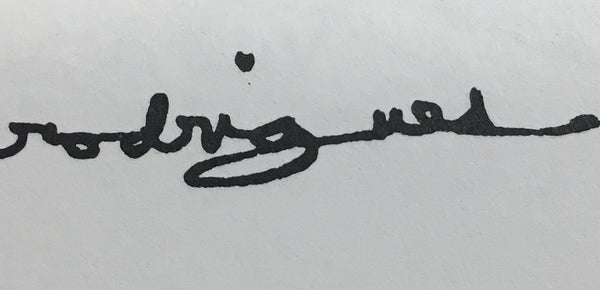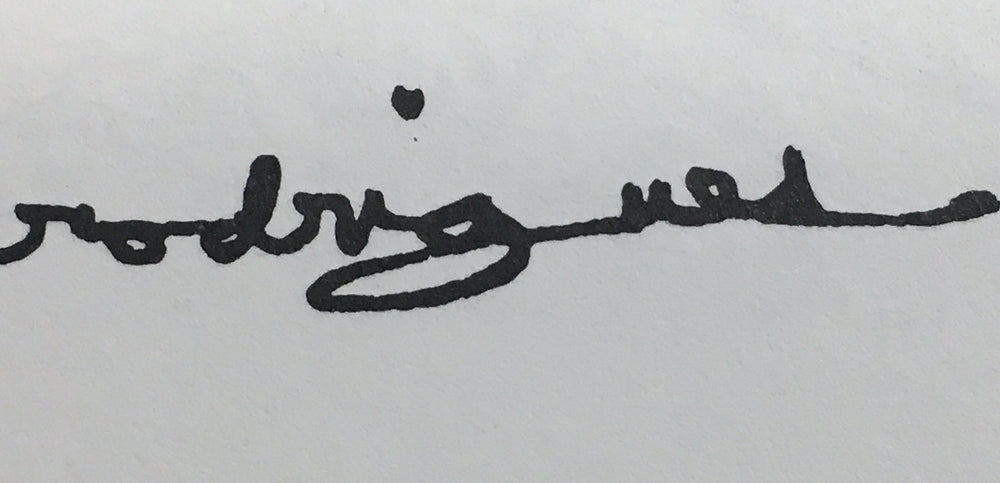[Rikki Farr had a long career as a raconteur and concert promoter, starting with the Beatles ‘way back at the dawn of time—well, the early ’60’s, anyway. Son of Tommy Farr, the British and Empire heavyweight champion who once fought Joe Louis at Yankee Stadium, brother to the late Gary Farr, popular UK blues singer, Rikki has been associated with everyone from Ella Fitzgerald to The Tubes, is well-remembered for his Isle of Wight rant in 1970, and has a million stories to tell. Copper‘s Dan Schwartz, veteran musician and #1 Beatles fan, had a lengthy, rambling conversation with Rikki at his office at Riva Audio, where Rikki is founder and guru. This is the first of three installments—come along for the ride!—Ed.]
D.S.: So – you came to the US in ‘78. I said you were a tax exile. You said what really happened was…
R.F.: If you recall, the Socialist government came into power – I think it was in what was ‘76 or ‘77. And for some reason, they decided – that all people in entertainment, and I never could figure this out – because a lot of the soccer stars were getting the same adulation, like George Best, they used to call that – the 5th Beatle. (laughs) And they put this, I think it was, 86% tax on everybody. Plus, they had this crazy idea of back taxes you owed. And it was just so unreasonable and unfair that there was a massive brain drain of musicians. Stones went to France, Floyd went off..,everybody, everybody left.
D.S.: Except Ringo. Ringo maintained a house, but he lived in Monaco too.
R.F.: Right. Well, you see, you could put the house in somebody else’s name. I had a beautiful farmhouse that I had renovated that was on the Lord Ingatestone estate, in Essex. And I had 18 acres. That is where I would go on weekends; I had a barn where I was recording, and I had indoor…it was just a beautiful farm. Lived in London on Kersey Street most of the time.
And there seemed to be, for some reason, a real class – I wouldn’t call it a warfare…but there was some sort of a real class..
D.S.: Resentment?
R.F.: …Distinction, they didn’t like. I used to go into the bank – I was doing quite well in those days – And I would go in and put my money in there; I had a buckskin jacket, long hair, whatever I was wearing…or what I wore in those days. And I mean, they would look at me. I would go into a bank meeting and some cocky little banker would say, “I saw you dressed for the occasion, Mr. Farr.” (laughs) And I would say, “I’ve come to visit my money. How’s it doing?”
(pause – phone alert) Wow. Won another award. I love it when it does that. (laughs)
And I would say, “I’ve come to visit my money. I wanted to see how well you’re doing with it. And if you make another comment about my dress, I will insist that you dress like me the next time I come to a meeting, or I will take my money away.”
I was cocky and arrogant, because you know what? I was sick and tired of class distinction that was in England. And you know, after the war, the country was so green and grey – I was born during the war – and everything was so drab, and the residual of the war had left the country colorless.
D.S.: I lived there in ‘68 and ‘69. And yes, it was still…
R.F.: In the sixties, we started Carnaby Street, the Marquee…
D.S.: It was coming alive.
R.F.: …yeah, the Court Eddie Club, the Rikki Tick…I had clubs all over. And we were johnny [?] working class young men, the exception being Pink Floyd, because they were out of Cambridge. The Stones were sort of working middle class, although Mick was at the London School of Economics. But generally, it was young, working class guys looking to make a name for themselves, and music – especially listening to American rhythm and blues, like the music coming over on Chess, Checkers, Jazz Select, ATCO, all those great (labels), the early Wilson Pickett, Sam and Dave, Bo Diddley, Chuck Berry…all of that music, the early music…Everly Brothers were a huge influence on the Beatles, for instance, with harmonies.
And you know, I had these clubs, and I was playing that music. People, young people, were listening to it and going to… like Chris Blackwell, who owned Island Records, and young Richard Branson, who, of course worked there. That’s how he started his mail order Virgin Records, he was importing these records and started selling them. And that’s how he started his empire.
D.S.: I actually own the – when he got rich off of “Tubular Bells”?
R.F.: Yeah. Mike Oldfield?
D.S.: He ordered the largest Helios console ever made?
R.F.: Right.
D.S.: I own it. Got it in storage, but I own it.
R.F.: Really?
D.S.: Yeah. Sir Richard sold it to a guy I met and I bought it from him.
R.F.: Oh, my goodness. Because we used to have the Manor recording track.
D.S.: Right. Wait – you had it? Or Sir Richard had it?
R.F.: Well he had it, but I used to use it at a place called the Roundhouse.
D.S.: Oh. What years did you used to run the Roundhouse?
R.F.: Well, it was Ian Knight, myself, a whole bunch of us were involved. I was bringing over the Jefferson Airplane, the Doors…
D.S.: So – late sixties?
R.F.: Late sixties, yeah. And I was bringing over artists for tours. We had then, Little Stevie Wonder, Wilson Pickett…oh God, we had so many…Clarence Walker…I had a lot of different rhythm and blues artists coming over, and I’d put them in the clubs and do certain town halls with them, and of course, they’d end up at the Roundhouse on a Sunday afternoon.
D.S.: Mmm-hmm. That became an institution, right? I mean, the Roundhouse gigs went on for many years.
R.F.: Yeah.
D.S.: A lot of the early punk stuff started there…
R.F.: Absolutely. We had the Sex Pistols there. We had the Clash, we had the Damned…
D.S.: I have a friend who played there with the Clash.
R.F.: The Clash? One of my favorite bands of all time, and some of the nicest people. But..yeah, it’s funny, when you start talking about these things, and you wonder: how did you compress all of this – from working in the early days with the Beatles, Ella Fitzgerald, The Modern Jazz Quartet, and Louie Armstrong – to Nirvana, the Beastie Boys, and everything in between you know? It’s been such an accelerated period of contemporary music and writing the like of which we – I won’t see again in my lifetime. It’s cyclical, so I’m sure there’ll be another era when…
D.S.: But that gets to…the question that I most have, looking through your videos… I have a lot of friends who were, you know, your age – who were musicians. They were in London, they were here, they were in New York – and then I came along a bit later, I was in the punk era. I see it as – the sixties happened. There was one discrete echo of the sixties, which was the punk era.
R.F.: Sure.
D.S.: And that lasted 4-5 years, and it’s been downhill since, in a way.
R.F.: Yeah.
D.S.: Do you have any understanding? Because, you’re not a player, right? The rest of the people I know are players. I’m a player.
R.F.: Well, I’m a very, very very bad drummer! (laughs)
D.S.: OK, good! Standing outside, looking in – booking the shows – do you have any understanding of what happened in that period in the late sixties? Why the writing was so dynamic? The music was so amazing? Look what happened to jazz in the late sixties, you know? I mean, Miles met Joe Zawinul, and BAM! They both went off in those directions. What I’m trying to figure out – what happened?
R.F.: I don’t think there’s a single answer to that, and I think it’s a very good question. There’s no quick off the hip answer, but I think music – and this may sound a little Gaelic, but I don’t care – but music is tribal. If you look throughout history, there were musical tribes. And it wasn’t just music. It was comedy. Out of Cambridge, there was Private Eye, Lenny Bruce was red hot, David Frost…
D.S.: So, the culture of tribes, you’re saying?
R.F.: Yeah, yeah. To me, it was very tribal and distinctly from various areas. And if you look down from Muscle Shoals to Liverpool to Birmingham, there were pockets of areas, geographically, where you can actually pinpoint: they came from here, here and there.
D.S.: Liverpool and its access to American recordings played a big part in the Beatles. Huge, huge.
R.F.: Because you have to remember, before there was the Beatles, there was the Downliner Sect…the very first, who was kind of not on the radar until they had a hit, was Manfred Mann. He was around for a long time.
D.S.: What did you say, the Downline..?
R.F.: Downliner Sect. They were, in a sense, a band that was playing a combination of traditional and modern jazz influences, but immediately early on latched onto the blues. And they were a band that the Stones looked at, and the Stones would support in the Cellar Club of London, 52 Room, places like that. And King Collier’s the allnighter, where people could listen to jazz all night; it was a place to sleep because you could lay down on the floors and sleep, wake up, have a coffee or Coca-Cola and listen to music…it was a place for people who didn’t want to go home – all the buses and trains had stopped. So there were these all nighters, and I used to put on a lot of these all nighters. Basically, they were crash pads for people who would listen to music, dance…
Drugs really wasn’t a part of that. There was some hashish floating around in those days. Some people would go up to Wellon Garden City and get some Purple Hearts. That was Keith Moon’s favorite pill of choice! (laughs) It’s an upper.
D.S.: Oh! I’ve never heard that term, “Purple Hearts.”
R.F.: Yes, it’s a little purple pill. I think they made them for soldiers to wake them up before they went into battle, or something like that. But you had to go up to Wellon Garden City to the back door of the manufacturer’s. It was so tame compared to the cynicism of what goes on today.
And people were listening to music, mainly from America…
D.S.: When are you talking about? The fifties?
R.F.: I’m talking the sixties.
D.S.: Ok.
R.F.: You know, Bo Diddley, Chuck Berry…even some of the early blues players – I had Howlin’ Wolf come over…
D.S.: Where did you have him play?
R.F.: I had him at the Marquee.
D.S.: So, what years did you manage the Marquee?
R.F.: Well, I wasn’t the manager. The Marquee was owned by Harold Pendleton, Chris Barber, and Kenny Ball, who were two jazz players, and the promoter of the Redding Jazz Festival. Business was falling down, and I had started putting on concerts, like the early Beatles. I was putting on concerts everywhere.
D.S.: The Beatles when they were the Silver Beatles, right? Before Brian Epstein?
R.F.: That’s before Brian. Brian was over the road at NEMS, which was his furniture store. And Brian had a little corner there, which was where he was selling imported records.
D.S.: Well, you know, the story is famous.
R.F.: Well, I only know – I live in a bubble, so..(laughs) Anyway, so Brian came over, saw the lads. There were a lot of bands in Liverpool at the time. Johnny B. Great, Rory Storm and the Hurricanes, which Ringo was playing in…
D.S.: Right. So when Ringo was with Rory Storm, that’s the period you were promoting the Beatles shows?
R.F.: Well, I met John in Hamburg in the sixties.
R.F.: (to unnamed female) What was the name of that club we went to? My memory…
U.F.: The one in Hamburg? Is it Kaiser Keller?
R.F.: Kaiser Keller. That’s right.
D.S.: Oh yeah. Very famously parodied in “Spinal Tap”.
R.F.: Right. Which I did all of the audio for. The production. I worked on “Spinal Tap”.
D.S.: So about your chance meeting with John Lennon, and how it pushed you to become involved in music. Do you think you would have ended up as a show promoter if you hadn’t met Lennon?
R.F.: No. I was really fascinated with Sean Kenney at the Brighton College Bar [?]. Sean Kenney was a great Set Director. And he was a great theatrical director using new geometric designs. He was a Renaissance Set Director and I was fascinated by lighting and set direction. And that’s been one of the pleasures of my work – being involved with the development of the sets for the artists – not just the audio.
D.S.: Now – you’re trained as an actor?— Or you did some training as an actor?
R.F.: What happened was – we didn’t find out until later – there were a whole set of young people who were growing their hair long, listening to music, going out all night, wearing, in a British point of view, outrageously colorful clothes…and I was not one of them, but I sort of became the Leader of the Pack.
D.S.: And that was where?
R.F.: This was down in Brighton, Hough, and London, and a little bit..anywhere around the south coast.
D.S.: Around the school, or..?
R.F.: Well, Brighton College of Art, was, of course, where Barbara Hill McKee [?], very famous designers, great fashion designers, Beepers, the whole Mary Quant, that kind of thing, came from. I was a terrible student, but what I did do – I started putting on the dances. So I became, for lack of a better word, the student social director, but I never saw myself like that.
I was busy going up north on the trawlers, making a lot of money as a deckie boy on the trawlers. I had a sports car, I had a beautiful apartment, I had lots of money in my pocket. So any chance I had, I’d go to Hough or Grimsby and sign on with a trawler, because it was pretty dangerous work.
D.S.: What were they fishing for?
R.F.: They were fishing for cod, haddock, and turbot. We would go out to the north, to Icelandic waters, Greenland…and it got pretty wild. I was in a few major storms, and I wondered if I was ever going to see light again…
D.S.: And now, you live here! (laughs)
R.F.: Right – but it was great coming off the boat, and chopping up ice blocks and laying them flat so the fish wouldn’t bruise, and having waves crashing over, and sort of being in a locker that was about the size of a coffin so you didn’t roll around…you know, and being with some of the hardiest, toughest men in the world. They really are tough. And I would come back down with a pocket full of money and I would go back. But I would have enough money to put on a show.
I remember at Brighton College of Art, I put on the seating – you call them trash bins here? In England, they call them dust bins. I put a dust man’s ball on, where I had all these dust bins hanging upside down on cables, with all the trash falling out, with lights inside it. We’d be flashing the lights while the trash was falling out. And this was a dance. We put on dances.
D.S: What was your motivation? Money? Fun?
R.F.: Fun. Fun… I mean, I should be a billionaire, if I’d really done things for money. I’d probably be knighted by the Queen for all of the concerts I’ve put on, you know, for Bangladesh and the concert at the Oval, Hello Summer…some of the guys that have worked for me have gone on to become knighted for their work. Once I moved to America, they carried on. And that’s great. Knighthood was not something that I’ve been looking for, frankly. (laughs).
D.S.: I don’t think anybody was.
R.F.: No, no. And my father, who was a great champion, he got an MBE, because they don’t knight boxers, even though he had a most memorable fight with Joe Louis…
D.S.: Really?
R.F.: …in 1937, in Yankee Stadium. For the world title. 15 rounds. And the King gave him the MBE. They knight jockeys, but not boxers. (laughs) Even though boxing was founded by Marquess of Queensbury. … So, yeah. They knight jockeys, but not boxers. [Farr-Louis bout can be seen here.—-Ed.]
Look, when I followed John, I ended up in Hamburg, this was in September. I’d come from Denmark, where I’d been working, and I didn’t have a work permit, so had to skidoodle quickly. But I had very little money in my pocket, so I’d got to Hamburg in the middle of the night by ferry. I was standing on a street corner, and in those days – they still do sometimes, they have a [German term for a food stall?]. I was going to have a chili dog and figure out where I was going to sleep: either at the YMCA or the Seamen’s Mission; I had enough money for that.
And I’d been in trouble in England for fighting. My father, being the heavyweight (champ) – at every pub, there’s always a lout who wants to put skin for the beer and get a notch on his belt, going, “Ahhr, I beat on Tommy Farr’s son!” So I was always like – and I had my brother with me, and he was young, but tough. Gary.
And one time, these taxi drivers came in and they were just so insulting, so rude, and so drunk, that I lost it. Went over the top, as they say. And if it hadn’t been 5 to 1 – and we wound up in front of a judge who knew my father – thank God.
And I was up for causing grievous bodily harm. Well, I was defending myself. I took a barstool and went crazy. I defended my family name and defended my father, who I love, and was a great man, and I didn’t need a bunch of drunk taxi drivers calling him all sorts of names – ‘cause they’d never say them to his face.
D.S.: Of course.
R.F.: So anyway, the judge says, “You go into the army or go back to your father.” So I said I’d go back to my father. My father was amazing. He said, “Frankly, if that were me and they hadn’t torn me away, they wouldn’t be alive.” The mining village where he came from? They wouldn’t be alive. He gave me some money and a passport and I took off to Sweden, because that’s where the pretty girls were. And I had a great time in Sweden. Started a business there, and it was quite successful. Then I moved down to Denmark, which I fell in love with. I went down there to listen to the early jazz they had there, Joe Morello on drums…got a job at a bar but didn’t have a work permit. So someone who wanted a job there ratted me out. So I got on the ferry to Hamburg.
So I’m standing on a street corner, it was raining, wherever it was, with about 10 DM to my name. I bought a chili dog from the cart, and I’m standing there, and all of a sudden a voice behind me goes [in John Lennon’s voice] , “Oh, I know you. You’re the boxer’s boy. You were in the newspapers. You were in trouble.”
I turn around, thinking here we go again – and it’s him. John.
D.S.: Bless your heart. [looking at photo on wall] Nice picture, by the way.
R.F.: Yeah, thank you.
D.S.: And this is with Pete Best, and…
R.F.: …and Stu.
D.S. Were they backing Tony Sheridan?
R.F.: Yes. That was the Kaiser Keller. And we sat at the bus shelter, because it was raining. I went there – we filmed there, recently. Nothing’s changed at the bus shelter except they don’t have the cars. They’ve put some sort of parking area…
So we sat at the bus shelter and we chatted, and he says, “Come over to the club.” I went down there, and the drunken sailors, the prostitutes, the cheap perfume, the beer…and just the wonderful, insidious music coming out of Bo Diddley, Chuck Berry, the Everly Brothers, and all renditions of that, I just fell in love. I just knew right away that in this wonderful decadence, that there was something…there was joy.
D.S.: And was Stu the bass player then?
R.F.: Yes.
D.S.: And how long were you there?
R.F.: I was there for – I stayed for 4 days, because I wanted to go down to Pamplona with my brother..that was another amazing story! (laughs)
So we ended up down by the docks, in Pedev [?] and I still had my Brighton College card, which I used remorselessly (laughs) even for semi begging. [Asks for aid to students in German] I learned to speak the language, I’d help them park their cars, or do something, and I’d get tips. That card fed Gary and I many times.
So we somehow convinced the Catholic Church there that we were artists, and we had ideas for great art. And they wanted to decide if this was true.
D.S.: Well, you knew kids in art school!
R.F.: Well, yeah. But I was totally into Georges Braque and Modigliani, and Mondrian. I loved Mondrian. So we had them set up this scaffolding, because there was this huge wall. And we said that we would paint this contemporary…so there was this young guy, I remember: Pito. Pito took us to this store where we bought all this paint, and the church paid for it, we got scaffolding. We were young and blond, and stripped to the waist, and the young Catholic girls would be coming by and we’d be having the time of our life. In fact, we ended up living above a brothel down by the docks.
D.S.: Oh, those were innocent days.
R.F.: Well, the beauty of the bar was, you’d get into this – almost like a harness, with leather straps. And you’d get into this barrel and drink the vino verde, and there was sawdust on the floor, so you’d drink until you’d throw up and have to clean up, and you’d just be swing in these (laughs) ..it’s just – and we’d have what I’d call, tapas.
Anyway, we painted this thing, and I was sort of ripping off Mondrian and Braque, and we put the dove with the peace and the halo, and Christ…and it really turned out great. And people wondered – I remember, one Sunday, we were nearly finished, and everyone in the church was loving it, and I remember on Sunday, we got one of those strange monsignors. And we thought we’d finish it on Monday and get out of there. I’d planned to hitchhike and get a boat back up to Liverpool.
And all of a sudden, Pito comes running in, “You die! You die! You die! They kill you! They kill you!” Well, my brother and I are pulling our pants on, because it’s Sunday in a brothel – what do you do? So, we’re getting our clothes on and he goes, “No, no, no, quick, quick, quick!” So Gary and I decide, “You go this way, I’ll go that way.” So Gary got to the docks and onto a boat called the SS Cave [?]. Had a German skipper. And he used to sail between the Canary Islands for pineapple and copper [inaudible]. So Gary got [inaudible] and hid there. I took off and I just remember I went into this tiny cafe that had these foul toilets, and I went into one of those toilets and just stayed there. Locked the door and just stayed in that toilet.
D.S.: Who was after you?
R.F.: They were after me because, what we didn’t know, was that the paint that they’d sold us was water based. When the rains came, the whole art piece came washing down the wall. So they thought we were..and then when they heard we were at a brothel…we were just bad dudes.
So with Gary, the German boat took off and sailed to Tahiti. And Gary stayed on it. That’s the boat that eventually got converted for Marlon Brando in Mutiny on the Bounty. They used it for the Bounty. They converted it. I got out and met the boys, and put on some shows…























